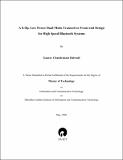A 0.18µ low power dual-mode transceiver front-end design for high speed bluetooth systems
Abstract
Today’s market trend is to possess a single multi-purpose, multi-functional personal device for various wireless personal area network (WPAN) applications. So it raises a great demand to develop multi-mode/multi-standard transceiver compatible to all these applications, which is a challengeable task. Moreover, today’s multi-media technology requires enhancement in speed performance. With respect to Bluetooth Standard, even version 1.2 with 1 Mbps data rate or version 2.0 + EDR with 2 or 3 Mbps data rate are not adequate considering current requirements. Bluetooth SIG has also specified another correlated standard called physical draft specifications with 4, 8 or 12 Mbps data rate to solve this issue. Currently, there are no transceivers available in the market that provides compatibility among all these versions. The core work of the thesis involves designing and analysis the multi-standard transceiver front-end system that gives compatibility with all three versions, solving RF design issues such like image rejection, flicker noise, DC offset etc. by using dual-conversion technique with choosing proper local oscillator frequency architecture. Furthermore, as Bluetooth is widely used in portable communication devices, its transceiver design requires miniaturization, long life of battery and cost-effectiveness. This thesis reports the transceiver analog front-end part designed with 0.18µ CMOS technology and 1.8 V supply. The improvement in power consumption has been obtained by implementing some recently developed low power designs of low noise amplifier, power amplifier, variable gain amplifier and limiter matching with the specifications derived through system design. Overall system and circuit-designs give very low system noise figure and hence, receiver sensitivity up to -92 dBm has been successfully achieved.
Collections
- M Tech Dissertations [923]

